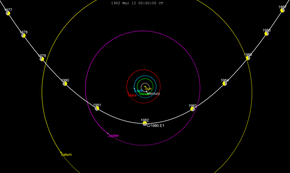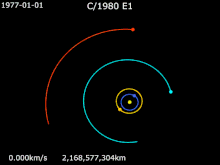C/1980 E1 (Bowell)
 Hyperbolic path with annual motion | |
| Discovery | |
|---|---|
| Discovered by | Edward L. G. Bowell |
| Discovery date | 11 February 1980 |
| Designations | |
| C/1980 E1 | |
| Orbital characteristics[2] | |
| Epoch | JD 2444972.5 (3 January 1982) |
| Observation arc | 6.88 years |
| Number of observations | 187 |
| Aphelion | ~75000 AU (inbound)[1] |
| Perihelion | 3.3639 AU[2] |
| Eccentricity | 1.057[2] (hyperbolic trajectory) 1.053 (epoch 1984+)[1] |
| Orbital period | ~7.1 million years (epoch 1950)[1] Ejection (epoch 1977+)[1] |
| Inclination | 1.6617° |
| 114.558° | |
| Argument of periapsis | 135.083° |
| Last perihelion | 12 March 1982[2] |
| Physical characteristics | |
| Dimensions | > 1 km |
C/1980 E1 is a
Overview
Before entering the inner Solar System for a 1982 perihelion passage, C/1980 E1 had a
As the comet was approaching on 9 December 1980, it passed within 0.228
perihelion on 12 March 1982,[2] when it had a velocity of 23.3 km/s (52,000 mph) with respect to the Sun. Since the epoch of 1977-Mar-04, C/1980 E1 has had a barycentric eccentricity greater than 1,[1]
keeping it on a hyperbolic trajectory that will eject it from the Solar System. Objects in hyperbolic orbits have a negative semimajor axis, giving them a positive orbital energy. After leaving the Solar System, C/1980 E1 will have an interstellar velocity () of 3.77 km/s.[a] The Minor Planet Center does not directly list a semimajor axis for this comet.[5]
The escape velocity from the Sun at Neptune's orbit is 7.7 km/s. By June 1995, the comet was passing Neptune's orbit at 30.1 AU from the Sun continuing its ejection trajectory at 8.6 km/s.[6] Since February 2008, the comet has been more than 50 AU from the Sun.[7]
| Date | Sun distance (AU) |
Velocity wrt Sun (km/s) |
Uncertainty region ( 3-sigma )
|
|---|---|---|---|
| 1682-03-12 | 248.8 AU (37.22 billion km; 23.13 billion mi) | 2.68 | ± 7 million km |
| Perihelion | 3.364 AU (503.2 million km; 312.7 million mi) | 23.3 | ± 1589 km |
| 2282-03-12 | 337.2 AU (50.44 billion km; 31.34 billion mi) | 4.43 | ± 5 million km |
Emission of OH (hydroxide) was observed pre-perihelion while the comet was nearly 5 AU from the Sun.[9] CN (cyanide) was not detected until the comet was near perihelion. The comet nucleus was estimated to have a radius of several kilometers. The surface crust was probably a few meters thick.


C/1980 E1 (Bowell) · Sun · · Earth · Mars · Jupiter · Saturn
See also
- List of Solar System objects by greatest aphelion
- List of hyperbolic comets
- List of non-periodic comets
- List of periodic comets
- 1I/ʻOumuamua
- 2I/Borisov
Notes
- ^ v = 42.1219 √1/r − 0.5/a, where r is the distance from the Sun, and a is the major semi-axis. At epoch 2500, C/1980 E1 will have a barycentric semi-major axis of −62.44.
References
- ^ Barycenter. Ephemeris Type:Elements and Center:@0 (To be outside planetary region, inbound epoch 1950 and outbound epoch 2050)
- ^ a b c d e f "JPL Small-Body Database Browser: C/1980 E1 (Bowell)" (last observation: 1986-12-30). Retrieved 26 September 2015.
- S2CID 119537175.
- ^
de León, Julia; Licandro, Javier; Serra-Ricart, Miquel; Cabrera-Lavers, Antonio; Font Serra, Joan; Scarpa, Riccardo; de la Fuente Marcos, Carlos; de la Fuente Marcos, Raúl (19 September 2019). "Interstellar Visitors: A Physical Characterization of Comet C/2019 Q4 (Borisov) with OSIRIS at the 10.4 m GTC". S2CID 204193392.
- ^ "C/1980 E1 (Bowell) Orbit at the Minor Planet Center". Retrieved 28 September 2015.
- ^ "Horizons Batch: Passing Neptune's orbit at 30.1 AU from the Sun" (Solar escape velocity at 30.1 AU is about 7.67 km/s). JPL Horizons.
- JPL Solar System Dynamics. Retrieved 22 February 2011.
- ^ "Horizons Batch for Distance and Velocity using a 300 year stepsize". JPL Horizons. Retrieved 3 February 2023.
- doi:10.1086/113552.
External links
- C/1980 E1 at the JPL Small-Body Database



